Re-tread legacy projects currently lead Lexington sweepstakes for “once in a century” Covid-relief funding
Council begins official debate next week on how to allocate what a syndicate of city leaders have termed, with pretty effective on-message consistency, a “once in a century opportunity” for Lexington.
Our syndicate is here referring to the city’s $120 million slice of the $1.9 trillion in federal American Rescue Plan Act (ARPA) money that remains President Joe Biden’s signature piece of legislation.
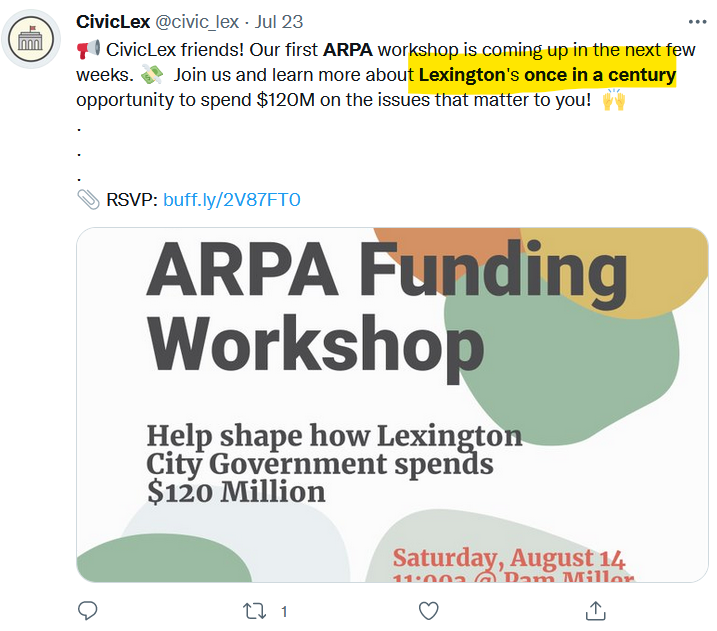
As our Great Leaders begin to winnow down the over 2,000 ideas submitted to it by area residents into 300 choice ideas, here are a few off-message story-lines that NoC is following. Let’s start with the obvious.
City leaders are brazenly lying about your once-in-a-century opportunity
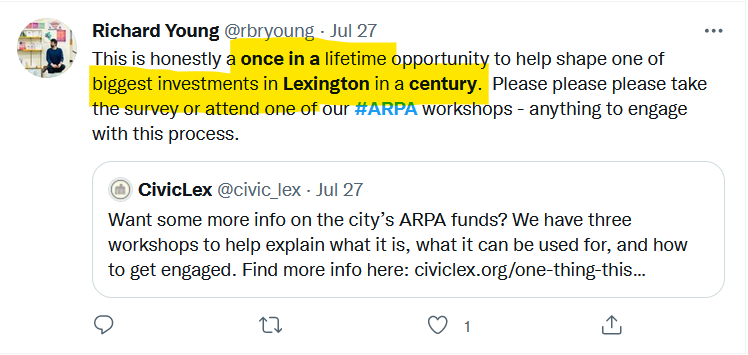
Last we checked, a century is short-hand for 100 years. If we are correct on this, then our syndicate of city leaders must surely be wrong in their assessment of Lexington’s $120 million ARPA subsidy. Just off the top of our head:
- 2010: $258 million in state, local, and federal dollars to pull off the World Equestrian Games. Money from Lexington’s allotment of the $800 billion Obama “Great Recession” stimulus contributed. (Yes, in the face of the greatest financial crisis since the Great Depression, our city chose “millionaire horse owners” as the local group in need of city support.)
- 2015: $300-350 million for Rupp Arena/Convention Center. (Yes again, see above.)
And these are just the big projects—double-ARPA’s, if you will. If one takes the four-year ARPA time-frame for enacting once-in-a-century ideas, then
- 2016-2020: $90 million in TIF and other subsidies for Main Street developers of CentrePointe, the East End, and 21C.
- 2017-2021: $110 million in Rupp/Main wrap-around support through the old courthouse renovation into a private event space and the nearly completed Town Branch bike-hike trail.
All told, that’s 4 ARPA’s in 12 years. Reduced even more: one ARPA every three years, a far far cry from one every century.
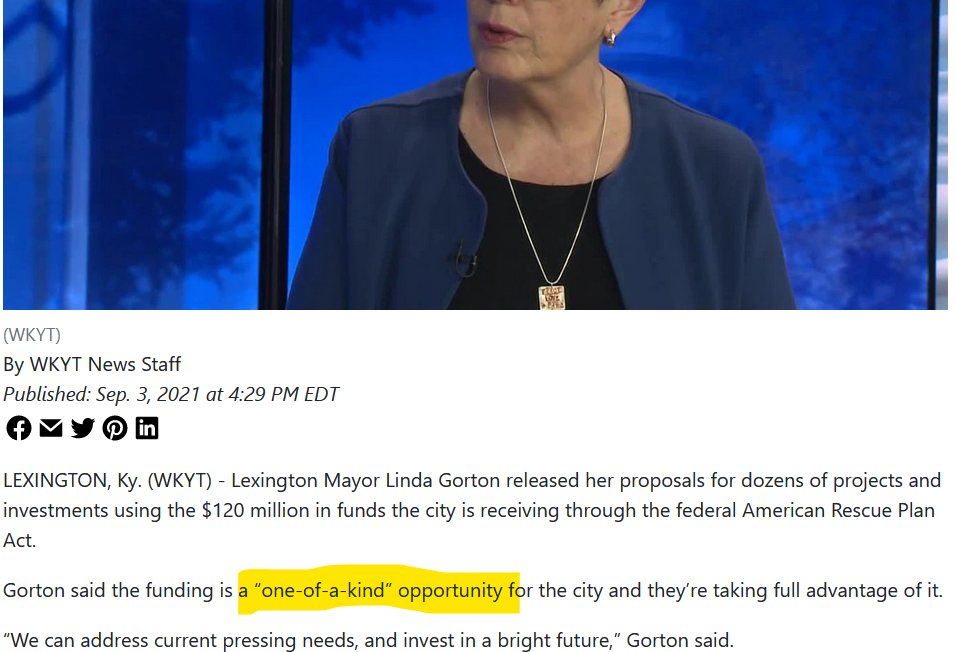
While it might not surprise that Mayor Linda Gorton and City Council have misrepresented our new $120 million in mostly free money as a historically unique opportunity, the parroting of this blatantly misleading idea by Lexington Herald Leader journalists and Herald-Leader/Facebook partner organizations like Civic Lex should be cause for community concern.
Much of last decade’s civic failures arose through a compliant media that often seemed to view themselves as strategic partners with the city’s political and other power centers. Thus, turd-ball double-ARPA-size arena overhauls were greenlighted without investigation. Billionaire families from Louisville that took million-dollar subsidies intended for low-income economic development got championed as hip artsy urban saviors. The white and wealthy lords gentrifying the northside became presented (as they hoped) as “ambassadors” to the people they were displacing.
All the pre-game pufferfishing about Lexington’s unique ARPA opportunity is more than just the harmless hyping of community amnesia. It all seems designed to make us forget the very recent and very poor history of most of these same city leaders in selecting and managing those other ARPA-like pots of gift-money.
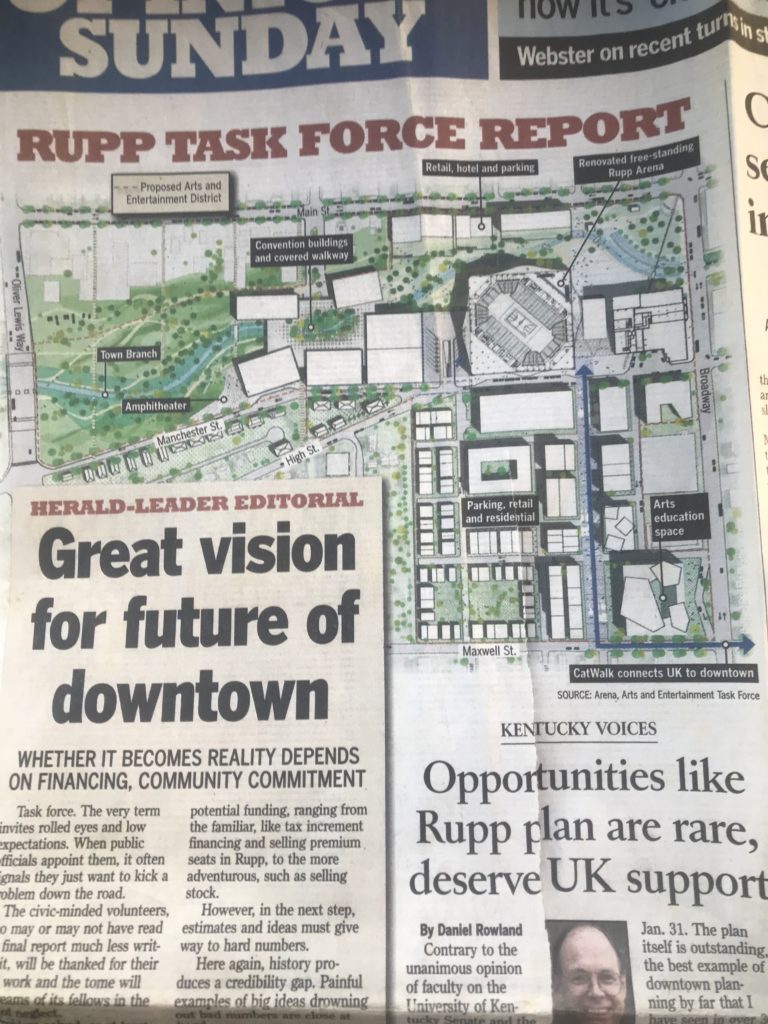
We are supposed to forget that whether it was a Council Member, a Herald Leader journalist, a UK professor or a CivicLex non-profiteer, pretty much the same cast of city leaders were saying pretty much the same things about unique and historic city opportunities for much of the past decade, and that to gain your shallow support for these fantastically expensive and elitist projects that contributed very little to the city, they were making similar claims about finally taking seriously your community input.
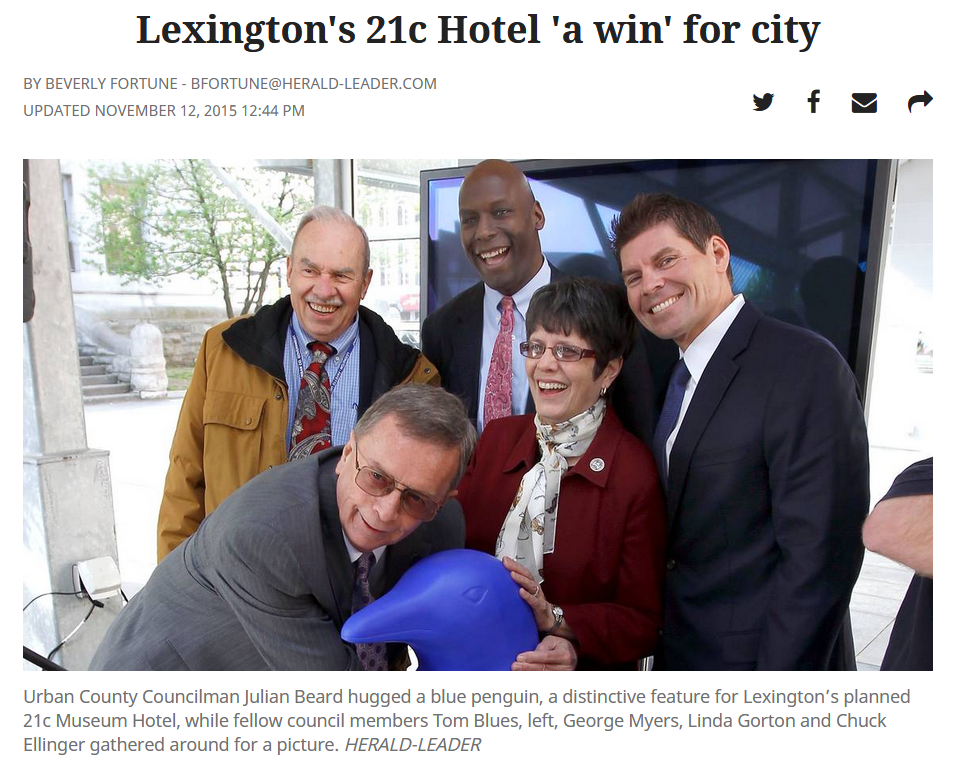
At some point, all these people making all this noise about valuing community input will surely start to look silly, like disconnected elites running a Banana Republic. Whether anyone in Lexington’s leadership syndicate breaks ranks to acknowledge this recent manipulation of community input for anti-community means will be something to look for as the ARPA debates commence.
Will ARPA funds mainly help traditional winners like UK, Fire, Police, and downtown?
The intent of the American Rescue Plan Act is to provide flexible funds to cities in order to help them “meet pandemic response needs and rebuild a stronger, and more equitable economy as the country recovers.” The Act’s wording recognizes the twinned pandemics that Americans experienced in 2020: first the health crisis, and then the inequality crisis that Covid exposed and exacerbated.
In what seems to be a bad-faith engagement of those federal principals, city leaders are currently pushing projects that directly benefit groups who have long received favored status in this city. These sorts of allocations have come in big chunks.

- A week before this city’s supposedly opening deliberations on ARPA spending, a 13-2 Council vote to direct $15 million (12% of Lexington’s total once-in-a-century-money) to a lump sum “Hero Pay” payment for “essential workers,” 80% of which will go to paying the city’s 1,400 firefighters and police officers whose Public Safety Department already accounts for nearly 60% of the total LFUCG annual budget. Council leaders were vague on if the money includes support for employees in historically underfunded departments like LexTran, garbage collection and City Parks, but we do already know, because Council made a point to stress this, that police and fire officers can expect to receive $5,000 apiece.
- An undisclosed amount for a new fleet of fire trucks is the main suggestion for addressing the Covid pandemic that the city’s Government Needs subcommittee could come up with. A 2017 article suggests the cost to be approximately $1 million per truck.
- $17.5 million (15% of once-in-a-century-money) for the University of Kentucky’s Coldstream Research Campus is Mayor Linda Gorton’s chief ARPA project. Despite already receiving a $30 million TIF from the city in 2019, Coldstream has been thus far greenlighted by CM’s Amanda Mays Bledsoe, Hannah Le Gris (a UK employee) and Fred Brown in the city’s Infrastructure subgroup, and also by CM’s Steve Kay, Preston Worley, and Susan Lamb in the Economic Development subgroup.
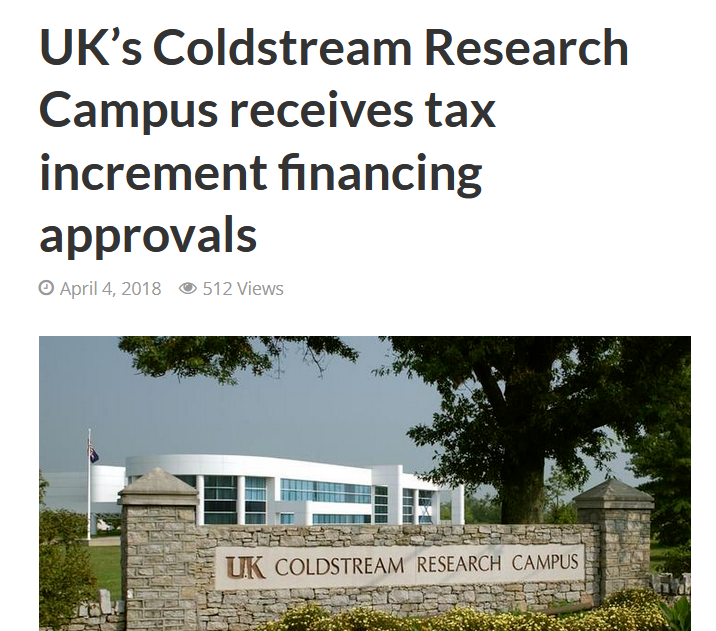
- $10 million for the Town Branch Commons (8% of once-in-a-century-money) is another idea greenlighted by the Economic Development subgroup (Kay, Worley, Lamb) for further council discussion. If ARPA money goes toward this Rupp Arena amenity, city leaders will have welshed on their 2016 promise to the community for the park to be “privately funded.”
- Undisclosed amount pushed by Mayor Gorton for a Youth Sports Complex that, when the project failed to gain Council approval in 2016, was projected to cost $26.7 million, or what would be about 25% of once-in-a-century-money.
- $57 million for upgrades to the Distillery District, located 600 steps west of Rupp Arena and the Town Branch Commons. This proposed allotment, which derives also from CM’s Kay, Worley and Lamb’s Economic Development subcommittee, would account for 50% of Lexington’s ARPA funds, though the CM’s (graciously) suggest that this money could be cut down once they find out what exactly the Distillery District developers want.
What you may notice about most of these projects is that, with the exception of the Hero Pay, none of them have anything to do with Covid. These are all big-ticket items that our city leaders began or attempted to begin last decade, a pre-Covid time when (as the ARPA act that is the source of this year’s once-in-a-century-money suggests) our economy was so rigged that it produced the sort of inequality that contributed to 2020’s pandemic. Creating the conditions for inequality-derived-crises to thrive and then later be slightly overcome with more once-in-a-century funding, it seems, is the industry at which this city excels above all else.
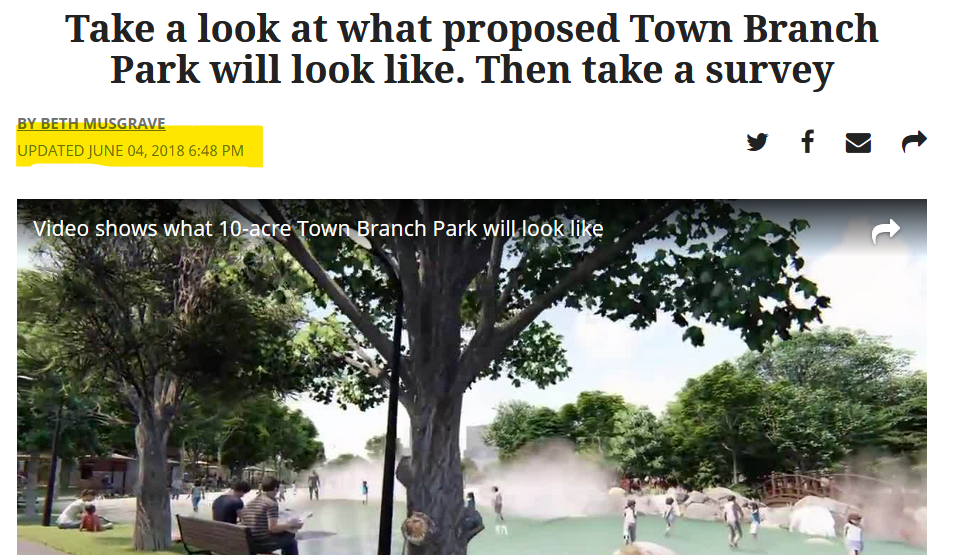
As our city leaders deliberate this unique spending opportunity, it will be interesting to track how much of this bold ‘build back better’ money specifically earmarked for low-income and marginal communities will instead go towards…simply paying to complete or augment last decade’s slew of upscale projects that our elite class of leaders ensured would finally fix this community.
My guess is that number will hover around 45%, $50-60 million of once-in-a-century-money, the off-the-top cost of doing business with our community betters. And not a single Syndicate Leader will say a word about this.
Are bold citizen projects too gosh-darn hard for our Whig council to take up?
On the other end of the spectrum from U.K. sits the vast majority of actual community submissions. Judging from the projects that Council Members have greenlighted out of their subcommittees, your community input was pretty much Kabuki Theater. In the hundreds of citizen submissions that I looked at, only a handful advocated helping UK to complete its Coldstream Campus ($17 million) or Rupp Arena to complete its Town Branch Commons ($10 million).
The vast majority of citizen submissions, meanwhile, focused on 3 things: creating bike/hike trails, improving park access, and funding housing initiatives. And yet, despite the overwhelming majority of citizens who were told by Syndicate Leaders that their voice matters and to submit a proposal to make positive change in their communities, very few citizen ideas made it past the sub-committee round of discussions.
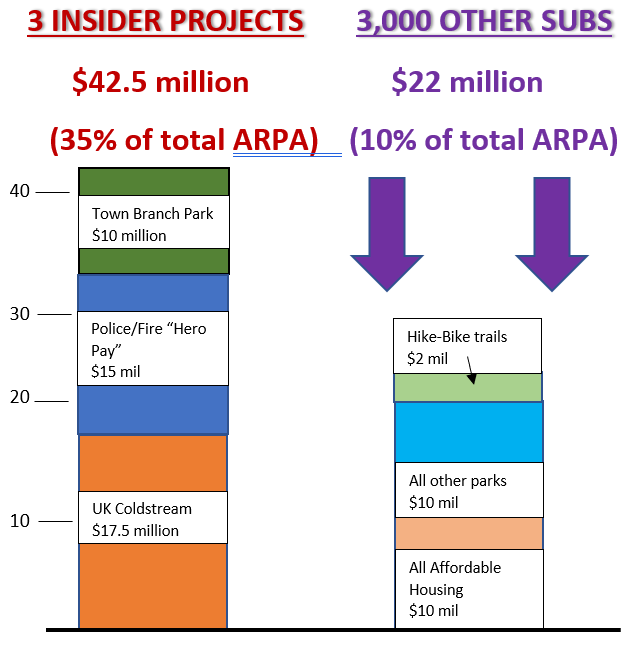
Mostly, Council Members publicly praised these true citizen proposals while simultaneously placing them into laughingly underfunded generic bundles. A few dozen affordable housing proposals became a single lump-sum $10 million commitment to Affordable Housing (8% of total once-in-a-century-money). A groundswell of ideas for better parks got transformed into a $10 million commitment to the city’s already-crafted Parks and Rec Master Plan.
A good example of this let’s not deal with yahoo ideas comes from the Infrastructure subcommittee of Amanda Mays Bledsoe, Hannah LeGris and Fred Brown. As this subcommittee greenlighted UK’s $17.5 million Coldstream ask, the group simultaneously bundled the nearly hundred bike-hike proposals into a single underwhelming $1.2 million proposal for “multi-modal connections.” It did this while suggesting that many submitted projects could not qualify for ARPA funds because they were not related to water, sewer, and broadband. (Dumb citizens! Just let UK take the sewer lead!)
This sort of $17 dollars for my real constituents, $2 dollars for you brand of leadership seems disproportionate, even for our Council Whigs. Such inequality in project selection between the city’s power players and everyone else is bound to produce only more of the social disjunction that already plagues most U.S. cities. Since, as it was designed, ARPA was about getting legitimately furious people to shut-the-FayetteUrbanCounty-up and get back to work, look for that ratio to be hemmed in somewhat, probably through a few tweaks around the edges that will be pufferfished by our area Bluegrass Pravda.
I admit, I, too, am interested to see how our Whig Council manages their complete dismissal of the citizens that they pushed so hard to contribute. With election season coming up, the very last thing they or any of their Syndicate Leader buddies want is for an ARPA contributor to comprehend that their idea for an Oxford Circle greenway or ag-based affordable housing complex lost out to the apparently vital need to complete SCAPE landscape’s $75 million Town Branch Commons–and to then get fed up enough to run for office against those do-nothing Whigs.
That seems to be the real issue our local leadership must now navigate as they work their way through this post-Covid woke funding to complete all their pre-Covid elitist tomfoolery.

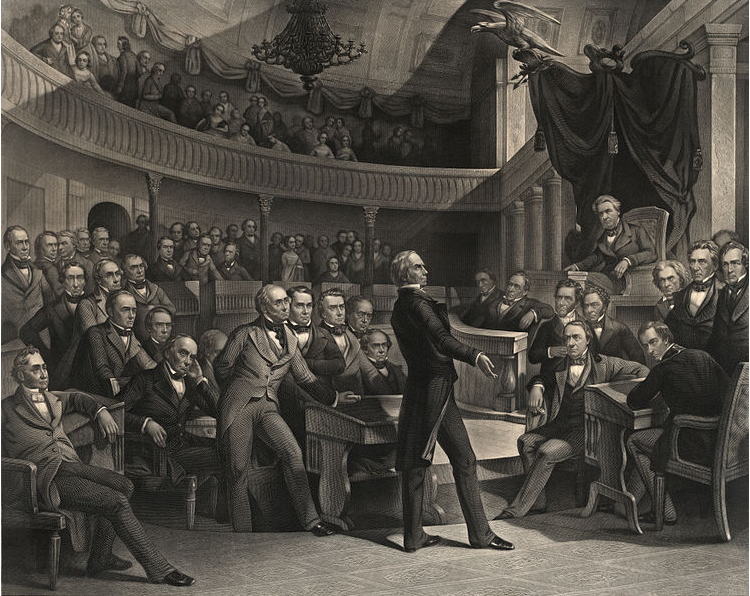

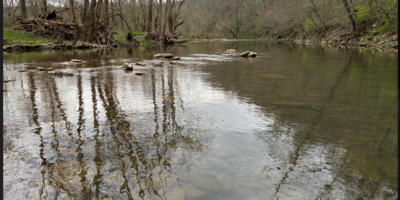

Michael Benton
Impressive reporting – thanks!